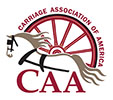
According to Carriage Terminology by Berkebile, the general belief is that the name is derived from the Celtic saint, Fiachra. How the carriage acquired the name is a little vaguer, possibly from the Paris inn named after St. Fiacre, in front of which the carriages stood, or possibly because a likeness of the saint was painted on the doors. St. Fiachra, also referred to as Saint Fiacre of Breuil, is known for having established a hospital in France for travelers and having used wheeled vehicles to carry the sick.
Regardless of how the name came about, all sources agree that in 1645, Nicholas Sauvage, set up shop outside the Hôtel de Saint Fiacre hired out his four-seater carriages. His carriages were rented at a rate of 10 sous an hour. His idea became one of the first citywide public transportation systems in France. The practice nearly died out but eventually went on to thrive, particularly as the vehicle design changed to something more closely resembling a six-passenger coach – “two [seats] on each of the transverse, vis-a-vis seats and one by each door, facing outward” according to Berkebile. By the time of the French Revolution there were 800 Fiacres in use. In Alfred Fierro’s Histoire et dictionnaire de Paris we learn more about the details of the Fiacre business:
- A decree of the Parlement of Paris in 1623 moved the business under government control with, Pierre Hugon, the sieur of Givry, having exclusive rights.
- Parlement fixed the fare in 1666 at twenty sous for the first hour
- By 1669 large numbers, in yellow paint, were required on the sides and rear of the coaches.


In 1855, Napoléon III monopolized the industry under the control of the Compagnie Impériale des Voitures à Paris (CIV). By 1860 CIV operated 3,830 fiacres and owned 8,000 horses and carried over 10 million passengers. They lost the monopoly in 1866. (Papayanis, “The Coachmen of Paris: A Statistical Profile” www.jstor.org/stable/260536)
In Alfred Fierro’s Histoire et dictionnaire de Paris it is noted that there were over ten thousand Fiacres operating in 1900, about the time for the first automobile taxis were introduced. The last horse-drawn fiacre disappeared in 1922 although a few are still used in the tourist trade.
By comparison, the Hansom Cab, a rental carriage that many are more familiar with, did not come into existence until 1843.

